The Tate’s very welcome exhibition of the great Indian painter Bhupen Khakhar (1934–2003) is the first international retrospective since the superb show held at the National Gallery of Modern Art in Mumbai three months after the artist’s death. The show takes its title from a picture painted in 1981. Ostensibly illustrating one of Aesop’s fables (still very popular as children’s books in India), the canvas is dominated by a naked man standing on a balcony and watching the story unfold beneath him in a series of simultaneous scenes in the manner of the Sienese masters whom Khakhar so much admired. As he explains in a 1983 Arts Council film included in the exhibition, for Khakhar the true moral of the tale is represented by the naked onlooker: ‘In life we all the time make social adjustments to please people around us. We forget our duty towards ourselves. What we should do in art and life is do exactly what one likes.’ Khakhar’s exuberant and idiosyncratic work is precisely the result of an artist doing what he liked, taking inspiration from wherever he found it to produce paintings, collages, drawings, etchings, watercolours, and even ceramics, which show many influences but are absolutely and unmistakably his own.
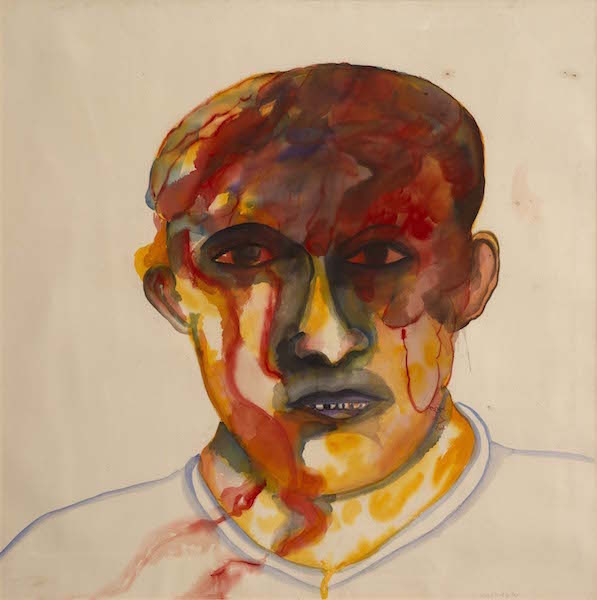
Injured Head of Raju (2001), Bhupen Khakhar. Courtesy of Estate of Bhupen Khakhar/National Gallery of Modern Art, New Delhi; © Estate of Bhupen Khakhar
These influences are astonishingly varied and not always obvious. Tiger and Stag (1970), for example, clearly nods to both Indian miniatures and Henri Rousseau, but the image of the animals was in fact taken from the wrapping of a firecracker. Khakhar collected such ephemera, along with the mass-produced secular and religious prints that are seen all over India, which he used in his early collages; but he equally drew upon ancient Rajasthani pichwai, devotional paintings telling the story of Krishna. Muktibahini Soldier with a Gun (1972), meanwhile, seems indebted to the folk-art tradition of Bengali patuas, notably in the figures of the soldiers in the background and in the use of decorative vertical borders, in this case the Indian and Bangladeshi flags.
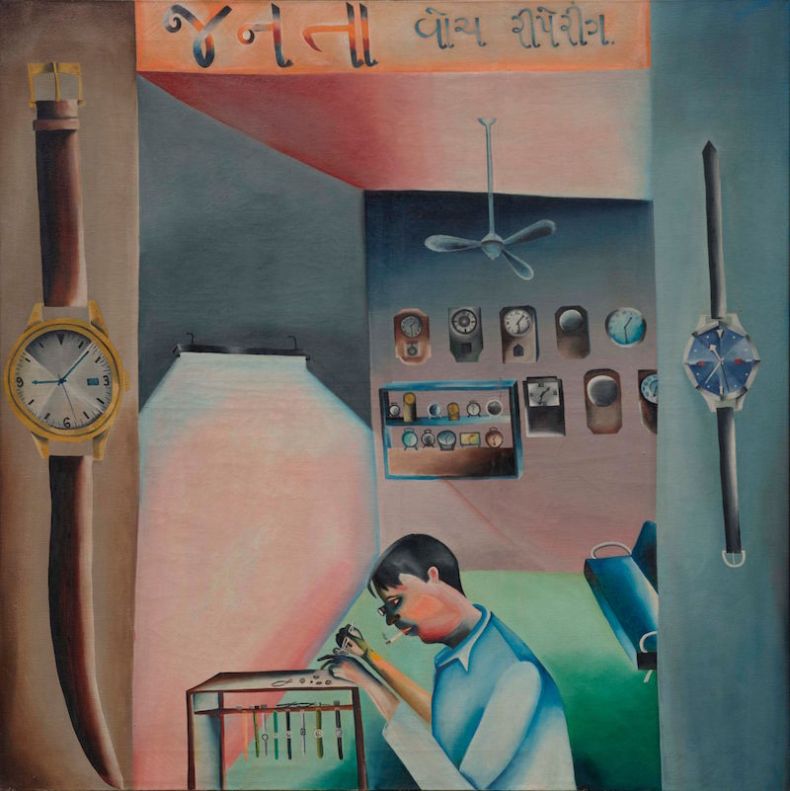
Janata Watch Repairing (1972), Bhupen Khakhar. Vivan Sundaram and Geeta Kapur; © Estate of Bhupen Khakhar
‘Human beings in their local environment, climate, provincial society: this should be the ultimate goal of the artist,’ Khakhar declared in 1978. The fact that he worked for 27 years as an accountant in the Gujarati city of Baroda led him to paint the people he encountered in his everyday life, seen clearly in a wonderful series of ‘trade paintings’ in the early 1970s; portraits of barbers, tailors, watch-menders and so on, painted on canvases the size of traditional shop-signs. Like his earlier collages, these faux-naïf pictures show the influence of Pop Art, but they are also essentially Indian, notably in their use of the bright colours with which shopkeepers in the subcontinent enliven their modest premises. Khakhar plays with perspective and incorporates out-of-scale objects in these paintings: the huge wristwatches framing Janata Watch Repairing or the small, doll-like mannequin in The De-Luxe Tailors, which seems to be taken from the ‘Ideal Boy’ educational charts found throughout India.
Later works are larger in scale and re-embrace the narrative painting that had for so many centuries been a principal feature of Indian art, while also drawing inspiration from murals by Mantegna and Lorenzetti. The unexplained disappearance of The Celebration of Guru Jayanti (1980) is a catastrophe, but the exhibition includes Yagnya (2000), in which the religious and secular aspects of a marriage are commemorated in a huge and populous panoramic diptych. It was Khakhar’s celebration of homosexuality, however, that caused controversy in a country that was, and remains, socially very conservative. You Can’t Please All (1981) is seen by some as his ‘coming out’ statement; thereafter homosexuality became a major theme of his work. My Dear Friend (1983) suggests the devotional aspect of sexual relations that was so important to Khakhar: the artist gazes at his friend and holds his hand, but the scene is carefully placed in, and so becomes part of, the ordinary daily life depicted in the painting’s background. Other paintings are much more explicit, and their action is sometimes put into a sacred context: Two Men in Banaras (1982) shows its naked and aroused subjects embracing against a backdrop of India’s holiest city, while Yayati (1987), in which a winged and priapic nude male lowers himself on to another man, is a sexualised version of a story from the Mahabharata.
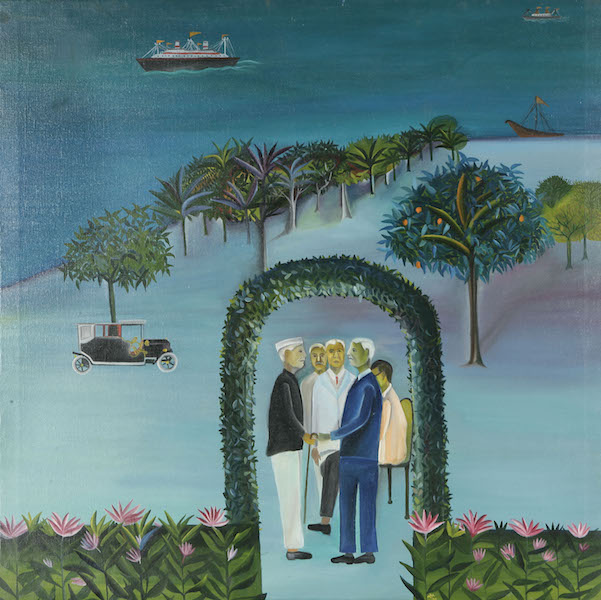
Man Leaving (Going Abroad) (1970), Bhupen Khakhar. Courtesy of Tapi Collection, India; © Estate of Bhupen Khakhar
The theme of intimacy and devotion is also suggested in Khakhar’s large watercolours, such as the Kalighat-style Ram Bhakt Hanuman (1998), in which the prince and the god embrace, and Picture Taken on Their 30th Wedding Anniversary (1998), in which the smiling wife absently cradles her husband’s penis in her hand. Perhaps more shocking to the Western eye are late paintings such as He Took Enema Five Times a Day (1999) and At the End of the Day Iron Ingots Came Out (1999), in which Khakhar unflinchingly portrays the pain and indignity he suffered as a result of the prostate cancer that eventually killed him. But then Khakhar was an artist whose work honoured life in all its aspects, and this exhilarating and wide-ranging exhibition rightly follows his example.
‘Bhupen Khakhar: You can’t please all’ is at Tate Modern, London, until 6 November.
From the July/August issue of Apollo: preview and subscribe here
Unlimited access from just $16 every 3 months
Subscribe to get unlimited and exclusive access to the top art stories, interviews and exhibition reviews.

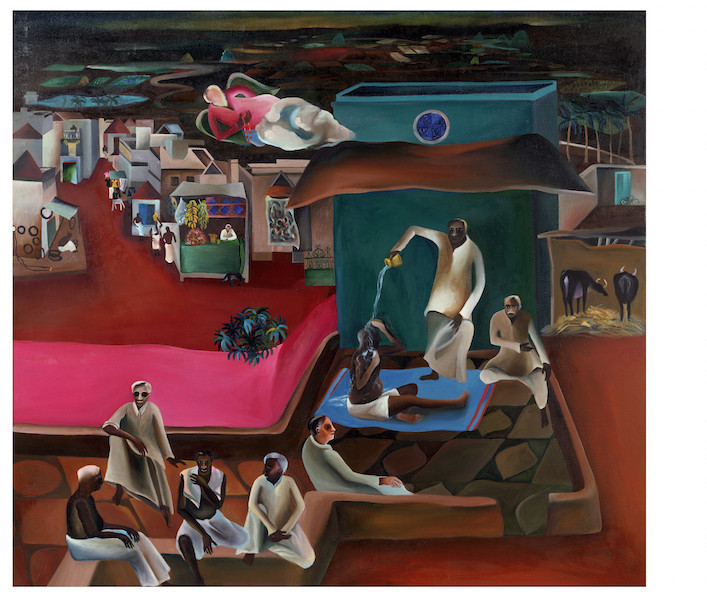
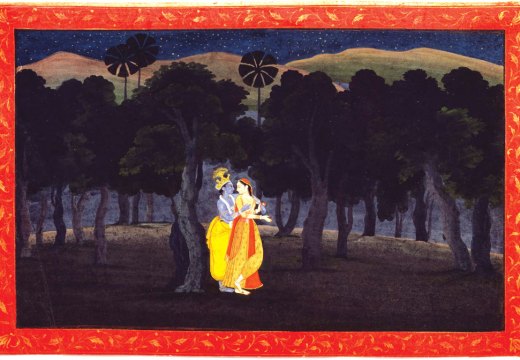
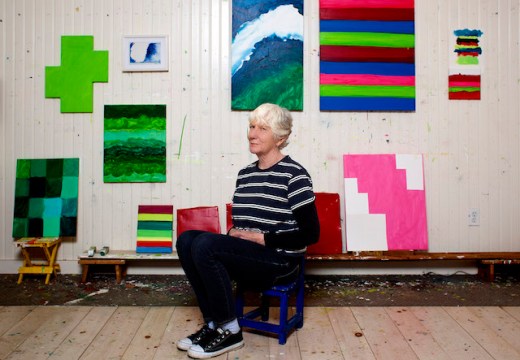
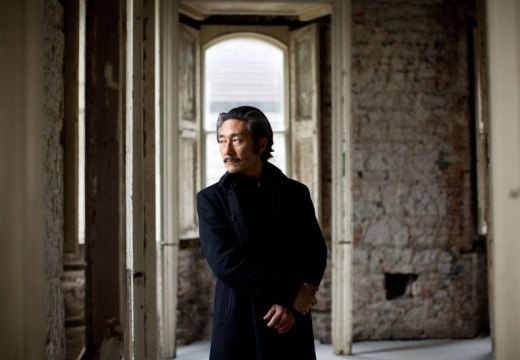









![Masterpiece [Re]discovery 2022. Photo: Ben Fisher Photography, courtesy of Masterpiece London](http://www.apollo-magazine.com/wp-content/uploads/2022/07/MPL2022_4263.jpg)
It’s time for the government of London to return to its rightful home